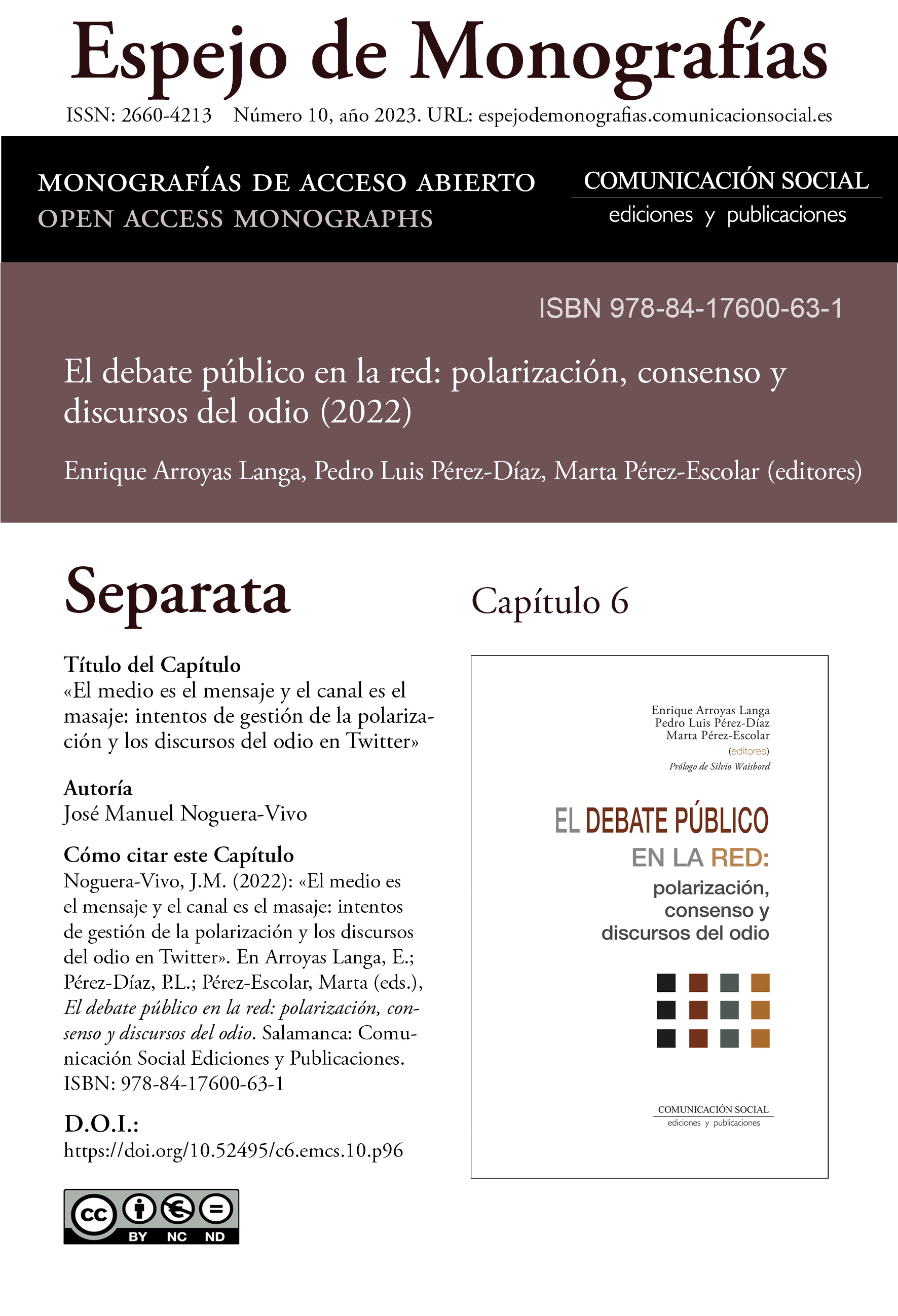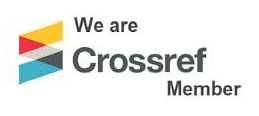Capítulo 6. El medio es el mensaje y el canal es el masaje: intentos de gestión de la polarización y los discursos del odio en Twitter
DOI:
https://doi.org/10.52495/c6.emcs.10.p96Resumen
Los medios sociales de internet acaban prestando utilidades moldeadas en última instancia por el usuario, pero definidas de inicio por las decisiones sistémicas y estructurales que toma cada plataforma. En medio de esta tensión recurrente, el medio social por excelencia para la conversación política y mediática, Twitter, ha cambiado durante los últimos años varios aspectos que definen su forma de consumo, especialmente después de que la red social fuera acusada —junto a Facebook— de haber promovido discursos del odio y polarizadores, de dirigentes políticos como Donald Trump. En este capítulo se repasan algunas de estas decisiones tomadas por Twitter entre 2019 y 2021, encaminadas a ofrecer una mejor experiencia de usuario pero que chocan con la realidad del consumo informativo actual, con una inevitable naturaleza accidental o, como matizan algunos autores, incidental. Entre las prácticas ofrecidas por una plataforma y las percibidas por los usuarios, surge una tercera modalidad: las prácticas reales de los ciudadanos en esa red social. Con este capítulo, veremos la necesidad de una mayor alfabetización mediática de los usuarios, para que esas prácticas reales sean más conscientes y socialmente responsables. Y también, la necesidad de avanzar hacia una teoría general de cómo se comparten las noticias (news sharing), especialmente en entornos digitales como Twitter, donde el paradigma de McLuhan se expone en su máxima expresión para que el canal sea el mensaje en sí mismo.
Palabras clave: twitter , polarización, consumo incidental, Contenido Generado por Usuario (CGU), innovación, medios sociales.
Descargas
Citas
Aguado, J.M. (2020). Mediaciones ubicuas. Ecosistema móvil, gestión de identidad y nuevo espacio público. Barcelona: Gedisa.
Bauman, Z. (2010). Vida líquida. Barcelona: Paidós.
Boczkowski, P.J.; Mitchelstein, E.; Matassi, M. (2018). ««News comes across when I’m in a moment of leisure»: Understanding the practices of incidental news consumption on social media». New Media & Society, vol. 20, núm. 10, pp. 3523-3539.
Cardoso, G. (2008). Los medios de comunicación en la Sociedad en Red. Filtros, escaparates y noticias. Barcelona: Editorial UOC.
Carpes, G.; Sanseverino, G.G. (2021). News consumption through social media and messaging applications. En R. Salaverría y M.F. De-Lima-Santos (Eds.), Journalism, data and technology in Latin America (pp. 195-228). Cham: Palgrave Macmillan.
Del Vicario, M.; Gaito, S.; Quattrociocchi, W.; Zignani, M.; Zollo, F. (2017). News consumption during the Italian referendum: A cross-platform analysis on Facebook and Twitter. En 2017 IEEE International Conference on Data Science and Advanced Analysis (DSAA) (pp. 648-657). Nueva York: IEEE.
Evans, S.K.; Pearce, K.E.; Vitak, J.; Treem, J.W. (2017). «Explicating affordances: A conceptual framework for understanding affordances in communication research». Journal of Mediated Communication, vol. 22, núm. 1, pp. 35-52.
García-Avilés, J.A. (2015). Comunicar en la Sociedad Red. Teorías, modelos y prácticas. Barcelona: Editorial UOC.
Jack, C. (2017). Lexicon of lies: Terms for problematic information. Data & Society. https://bit.ly/3G5KbjW
Klayman, J. (1995). «Varieties of confirmation bias». Psychology of Learning and Motivation, vol. 32, pp. 385-418.
Kreiss, D.; Lawrence, R.G.; McGregor, S.C. (2018). «In their own words: Political practitioner accounts of candidates, audiences, affordances, genres, and timing in strategic social media use». Political Communication, vol. 35, núm. 1, pp. 8-31.
Kwon, S.J.; Park, E.; Kim, K.J. (2014). «What drives successful social networking services? A comparative analysis of user acceptance of Facebook and Twitter». The Social Science Journal, vol. 51, núm. 4, pp. 534-544.
Mellado, C.; Hermida, A. (2021). «A conceptual framework for journalistic identity on social media: How the personal and professional contribute to power and profit». Digital Journalism, publicación avanzada en línea. https://bit.ly/33pEzmt
Moreno, M. (2020, 12 de noviembre). Twitter lanza los anuncios en forma de carrusel. TreceBits. https://bit.ly/3d6yX2b
Noguera-Vivo, J.M. (2018). Generación efímera. La comunicación de las redes sociales en la era de los medios líquidos. Salamanca: Comunicación Social.
Noguera-Vivo, J.M. (2019). The (private) news sharing report. A starting guide for researchers and journalists. https://bit.ly/32CprSt
_(2021). A journalistic approach to the IDN when the user is the message: The JUC model for content strategy. https://bit.ly/3Ehduzw
Rosalía [@rosalia] (2021, 12 de abril). El algoritmo es un aburrimiento... [Tuit]. Twitter. https://bit.ly/30Zx4Bf
Schram, R. (2020). «The state of the creator economy». Journal of Brand Strategy, vol. 9, núm. 2, pp. 152-162.
Scolari, C.A. (2008). Hipermediaciones. Elementos para una Teoría de la Comunicación Digital Interactiva. Barcelona: Gedisa
Segado-Boj, F.; Díaz-Campo, J.; Navarro-Asensio, E.; Remacha-González, L. (2020). «Influence of News-Finds-Me perception on accuracy, factuality and relevance assessment. Case study of news item on climate change». Revista Mediterránea de Comunicación, vol. 11, núm. 2, pp. 85-103.
Serrano-Puche, J. (2021). «Digital disinformation and emotions: exploring the social risks of affective polarization». International Review of Sociology, vol. 31, núm. 2, pp. 231-245.
Siegel, A.A.; Nikitin, E.; Barberá, P.; Sterling, J.; Pullen, B.; Bonneau, R.; Nagler, J.; Tucker, J.A. (2021). «Trumping hate on Twitter? Online hate speech in the 2016 and its aftermath». Quarterly Journal of Political Science, vol. 16, núm. 1, pp. 71-104.
Twitter (2021). Las reglas de Twitter. Twitter. https://bit.ly/3oefse4
Twitter España [@TwitterEspana] (2020, 22 de octubre). ¡No te quedes en el… [Tuit con vídeo]. Twitter. https://bit.ly/3xK2dF6
Twitter Support [@TwitterSupport] (2020, 10 de junio). Sharing an article can spark… [Tuit]. Twitter. https://bit.ly/32z0CGX
Vega, N. (2020, 24 de noviembre). Twitter will now warn users if they try to like a ‘misleading’ tweet. New York Post. https://bit.ly/3CREO5F
Villi, M.; Noguera-Vivo, J.M. (2017). «Sharing media content in social media: The challenges and opportunities of user-distributed content (UDC)». Journal of Applied Journalism & Media Studies, vol. 6, núm 2, pp. 207-223.
Waisbord, S. (2020). «¿Es válido atribuir la polarización política a la comunicación digital? Sobre burbujas, plataformas y polarización afectiva». Revista SAAP, vol. 14, núm. 2, pp. 249-279.
Wardle, C.; Derakhshan, H. (2017). Information disorder: Toward an interdisciplinary framework for research and policymaking. Consejo de Europa. https://bit.ly/3CThDbf
Williams, E. (2009, 27 de febrero). Evan Williams habla sobre escuchar a los usuarios de Twitter [vídeo]. YouTube. https://bit.ly/3xHKGxq
Wong, J.M. [@wongmjane] (2021, 15 de junio). Twitter is working on Tweet... [Tuit con imagen]. Twitter. https://bit.ly/32K7O2V
Zuckerberg, M. (2018, 15 de noviembre). A blueprint for content governance and enforcement. Facebook. https://bit.ly/3xnZ5yT

Publicado
Cómo citar
Número
Sección
Licencia

Esta obra está bajo una licencia internacional Creative Commons Atribución-NoComercial 4.0.
Los artículos publicados en la revista se distribuyen con la Licencia Creative Commons Atribución-NoComercial-SinDerivadas 4.0 Internacional










